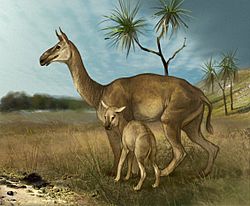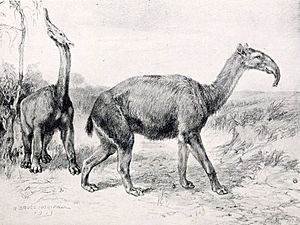Macrauchenia facts for kids
Quick facts for kids MacraucheniaTemporal range: Late Miocene to Late Pleistocene
|
|
|---|---|
 |
|
| Artistic drawing of Macrauchenia | |
| Conservation status | |
|
Fossil
|
|
| Scientific classification | |
| Kingdom: | |
| Phylum: | |
| Class: | |
| Order: |
†Litopterna
|
| Family: |
†Macraucheniidae
|
| Genus: |
†Macrauchenia
|
| Binomial name | |
| Macrauchenia patagonica Owen, 1838
|
|
Macrauchenia was an early hoofed mammal with a long neck; it may have had a long trunk. This quadruped lived during the Pleistocene. Fossils of Macrauchenia have been found in Argentina, South America. Macrauchenia was an herbivore that had high-crowned cheek teeth.
Contents
Description
Macrauchenia had a somewhat camel-like body, with sturdy legs, a long neck and a relatively small head. Its feet, however, more closely resembled those of a modern rhinoceros, and had toes hooves each. It was a relatively large animal, with a body length of around 3 metres (9.8 ft) and a weight up to 1042.8 kg.
One striking characteristic of Macrauchenia is that, unlike most other mammals, the openings for nostrils on its skull were atop the head, leading some early scientists to believe that, much like a whale, it used these nostrils as a form of snorkel. Soon after some more recent findings, this theory was rejected. An alternative theory is that the ungulate possessed a trunk, perhaps to keep dust out of the nostrils. Macrauchenia's trunk may be comparable to that of the modern Saiga antelope.
One insight into Macrauchenia's habits is that its ankle joints and shin bones may indicate that it was adapted to have unusually good mobility, being able to rapidly change direction when it ran at high speed.
Macrauchenia is known, like its relative Theosodon, to have had a full set of 44 teeth.
Paleobiology
Macrauchenia was a herbivore, likely living on leaves from trees or grasses. Carbon isotope analysis of M. patachonica's tooth enamel, as well as analysis of its hypsodonty index (low in this case; i.e., it was brachydont), body size and relative muzzle width suggests that it was a mixed feeder, combining browsing on C3 foliage with grazing on C4 grasses. Scientists believe that, because of the forms of its teeth, Macrauchenia ate using its trunk to grasp leaves and other food. It is also believed that it lived in herds like modern-day wildebeest or antelope, the better to escape predators.
When Macrauchenia first arose, it would have been preyed upon by the largest of native South American predators, terror birds such as Andalgalornis, and carnivorous sparassodontids such as Thylacosmilus. During the late Pliocene/Early Pleistocene, the Panama Isthmus formed, allowing predators of North American origin, such as the cougar, the jaguar, the South American giant short-faced bear, the dire wolf and the saber-toothed cat, Smilodon, to emigrate into South America and replace the native forms.
It is presumed that Macrauchenia dealt with its predators primarily by outrunning them, or, failing that, kicking them with its long, powerful legs, much like modern-day vicuña or camels. Its potential ability to twist and turn at high speed could have enabled it to evade pursuers.
Images for kids
See also
 In Spanish: Macrauchenia para niños
In Spanish: Macrauchenia para niños








